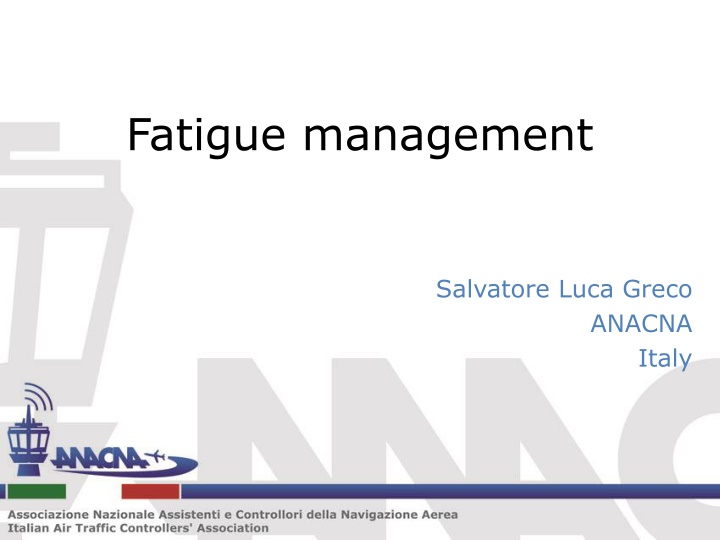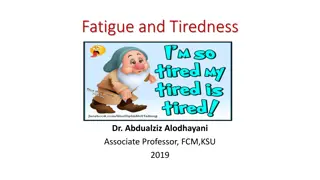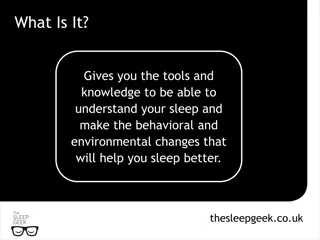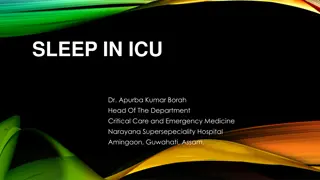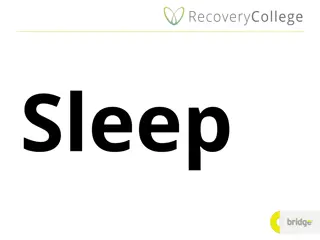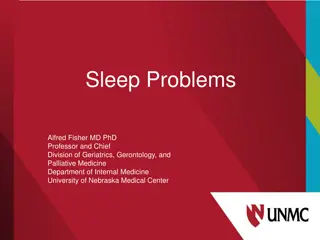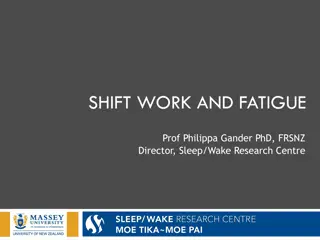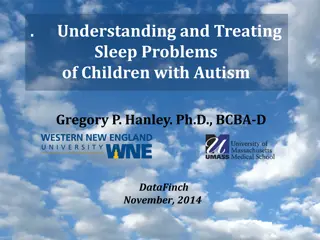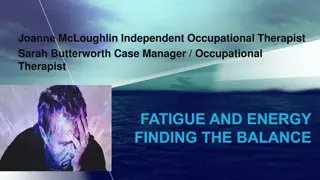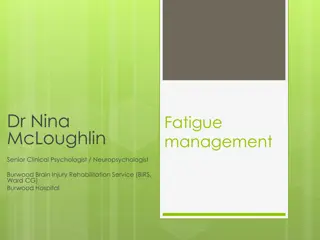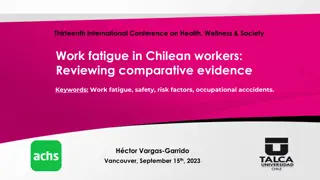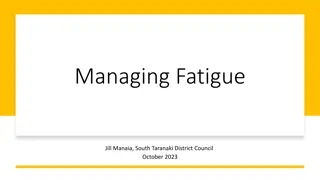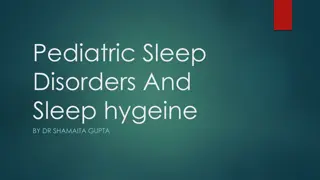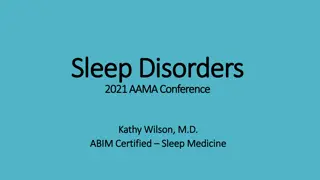Fatigue Management and Restorative Sleep
Fatigue, as a physiological state affecting performance, is a significant concern in various contexts. This content delves into the causes and consequences of fatigue, emphasizing the importance of managing it effectively. Additionally, it discusses the need for restorative sleep, outlining the stages of Non-REM and REM sleep cycles. Factors influencing sleep quality and the impact of sleep restrictions on performance are also explored, highlighting the intricate relationship between fatigue, sleep, and overall well-being.
Download Presentation

Please find below an Image/Link to download the presentation.
The content on the website is provided AS IS for your information and personal use only. It may not be sold, licensed, or shared on other websites without obtaining consent from the author.If you encounter any issues during the download, it is possible that the publisher has removed the file from their server.
You are allowed to download the files provided on this website for personal or commercial use, subject to the condition that they are used lawfully. All files are the property of their respective owners.
The content on the website is provided AS IS for your information and personal use only. It may not be sold, licensed, or shared on other websites without obtaining consent from the author.
E N D
Presentation Transcript
Fatigue management Salvatore Luca Greco ANACNA Italy
Fatigue: what are we talking about? A physiological state of reduced mental or physical performance capability resulting from sleep loss or extended wakefulness, circadian phase or workload (mental or physical activity, or both) that can impair an individual's alertness and ability to safely perform his/her tasks; Eu. Reg 373/2017
Fatigue: why are we talking about it? Satisfying increased demand for capacity while maintaining safety Strong link between fatigue, stress and performance.
Fatigue is affected by all waking activities. Fatigue management is a shared responsibility between Individuals ANSPs
The need for sleep Sleep types Non-REM (NREM) REM
Non-REM sleep Quiet brain and quiet body. Brainwave activity slows down. Phase 1 Light sleep Three stages of NREM sleep Phase 2 Deep sleep SWS Slow wave sleep Phase 3 Muscles grow, damaged tissues get repaired. SWS is necessary for learning
REM sleep Busy brain and paralized body. Brainwave activity looks similar to waking activity. The body can t move. Electric signals from brain do not get through spinal cord. People awaken from REM recall vivid dreaming. Brief paralysis sometimes experienced after waking up. Brain repairs itself during REM sleep.
Factors affecting sleep quality Caffeine Nicotine Alcohol Environmental factors (light, temperature) Unfamiliar environment Time on-call
Shift and fatigue How is sleep-wake cycle defined? Circadian body clock (or circadian rhythm) sleep homeostatic process Light-stimulated electric signals from eyes to brain, to keep body sincronized with day/night cycle. Need for sleep increases as time spent awake passes. Endogenous substance (Adenosine) is created during the day, leading to sleepines. WOCL
Workload and fatigue ICAO defines workload as mental or physical activity and recognizes it is a potential cause of fatigue. Three main aspects of workload: Nature and amount of work to be done (including time on task, task difficulty and complexity, and work intensity). Time constraints. Factors relating to the performance capacity of an individual (for example experience, skill level, effort, sleep history, and circadian phase). High and low workload can contribute to fatigue. Also, think about continuous changes in tasks, technology & rules Source: Fatigue management guide for Air traffic services providers IFATCA, CANSO, ICAO (2016, first edition)
Fatigue management methods The prescriptive approach The proactive approach FRMS Fatigue risk management system
The prescriptive approach ICAO requires States to develop regulatory limits for work and non-work periods. Last minute duty extensions flexibility to manage operational disruptions. Fatigue risks can be managed using existing SMS processes.
The prescriptive approach HOW TO? - Comply with prescribed limits (social regulations can unintentionally help the fatigue management process) - Use scientific principles in rostering (Be aware of Circadian rhytms, WOCL) - Use caution while assigning unscheduled shifts ATCOs should be careful when swapping shifts
The prescriptive approach Staying within prescribed limits may not be enough to manage fatigue.
The proactive approach - FRMS A data-driven means of continuously monitoring and managing fatigue-related safety risks, based upon scientific principles and knowledge as well as operational experience that aims to ensure relevant personnel are performing at adequate levels of alertness. ICAO DOC 9966 Manual for the oversight of fatigue management approaches 2 edition, 2016
Why a FRMS? With a prescriptive approach, fatigue is one of the possible hazards that the SMS should consider but data-driven evidence related to fatigue is not specifically and actively collected unless a fatigue issue has been identified by the SMS. The ANSP reacts when a fatigue hazard is identified.
FRM process Using a FRMS, the Service Provider must additionally identify and assess potential fatigue risks prior to conducting operations, as well as identifying and assessing actual fatigue risks proactively during operations. Monitor operations using proactive, predictive and reactive approach Identify fatigue hazards Mitigate risks Assess risks
FRMS - Monitoring phase Three ways of hazard identification: - Proactive: Measuring fatigue levels in normal day-to-day operations - Predictive: Examining scheduled rosters - the fatigue management way - Reactive: Assessing the contributions of fatigue to safety reports/events PROACTIVE PREDICTIVE REACTIVE Self reported fatigue risks Previous experience Safety reports Fatigue surveys Evidence based rostering Event investigations Safety databases Bio-mathematical models Scientific studies Sleep monitoring
FRMS Risk assessment Assessing fatigue risks is a complex process: - Complex interaction between fatigue and performance. Fatigue is rarely the only cause of an event, but it is often a contributing factors. - Methods need to be used with full knowledge of potential and limitations. - Fatigue management is under continuous development: fatigue risk assesment processes might change as more experience in fatigue management is achieved all over the world.
FRMS Risk assessment METHODS A risk assessment matrix can be used to calculate fatigue safety risk. Source: ICAO DOC 9859 Safety Management Manual
FRMS Risk assessment METHODS A risk assessment matrix can be used to calculate fatigue safety risk. Safety risk is defined as the projected likelihood and severity of the outcome from an existing hazard When managing fatigue risks, different severity classification are needed. Examples are: - Subjective sleepiness scale (Samn-Perelli, KSS)
FRMS Risk assessment METHODS A risk assessment matrix can be used to calculate fatigue safety risk. Safety risk is defined as the projected likelihood and severity of the outcome from an existing hazard When managing fatigue risks, different severity classification are needed. Examples are: - Subjective sleepiness scale (Samn-Perelli, KSS) - Bio-mathematical models (Not to be used as a stand alone method!) - Assessing the number of relevant fatigue factors associated with a specific duty or work pattern
FRMS Risk mitigation Risk assessment determines whether or not risk mitigation is required Mitigations are costly in terms of HR, time, money Need for a careful selections of fatigue risks to be mitigated, going beyond duty and rest times!
point of view - Prescriptive approach may not be enough for an effective fatigue management. Let s go (together!) beyond sleep and duty times - FRMS implementation is fundamental - A proper caution in shift swap and rest times is required. ATCOs, FISO, and anyone involved in the provision of ANS shall be aware of fatigue risks - In high workload environment no operational duty shall exceed a period of two hours without there being taken during, or at the end of that period, a break totalling not less than 30 minutes, as a strong decrease in performance is generally observed after two hours on duty.
QUESTION TIME Further readings: - IFATCA, CANSO, ICAO (2016) Fatigue management guide for Air Traffic Services Providers, first edition. - ICAO (2016) DOC9966 - Manual for the Oversight of Fatigue Management Approaches, Second Edition. - Gander, P. (2001), Fatigue management in air traffic control: the New Zealand Approach, Transportation Research Part F: Traffic Psychology and Behavior, 4(1), 49-62. - EUROCONTROL (2018) Fatigue and sleep management CONTACT: Luca Greco salucagreco@gmail.com info@anacna.it
